Variability of Trends in Precipitation across the Amazon River Basin Determined from the CHIRPS Precipitation Product and from Station Records
Abstract
1. Introduction
2. Material and Methods
2.1. The CHIRPS Dataset
2.2. Precipitation Records in the Amazon Basin
2.3. Methodology
2.3.1. CHIRPS and Ground Station Analysis
2.3.2. Synchronized Station Analysis
2.3.3. Standard Analysis of the Trend Extremes
2.3.4. Comparison with the Evapotranspiration Component of the Water Balance
3. Results
3.1. Spatial Analysis
3.2. Synchronized Stations
3.3. Trend Variability
3.4. Evapotranspiration and CHIRPS Comparison
4. Summary and Conclusions
Author Contributions
Funding
Acknowledgments
Conflicts of Interest
References
- Funk, C.; Verdin, A.; Michaelsen, J.; Peterson, P.; Pedreros, D.; Husak, G. A global satellite-assisted precipitation climatology. Earth Syst. Sci. Data 2015, 7, 275–287. [Google Scholar] [CrossRef]
- WMO. Guide to Meterological Instruments and Methods of Observation; WMO: Geneva, Switzerland, 2008. [Google Scholar]
- Victor Hugo da Motta, P.; de Aline Maria Meiguins, L.; de Andressa Macêdo Silva, A.; Julio Domingos Nunes, F.; de Johelder Eduardo Fornari, S. Condições de operação e implantação de estaçòes da rede hidrométrica da Amazônia Oriental, Estado do Pará. XIX Simpósio Bras. Recur. Hídricos 2011, 1–14. Available online: http://rigeo.cprm.gov.br/jspui/bitstream/doc/1119/1/Evento_Consid_Paca.pdf (accessed on 27 April 2020).
- Victor Hugo da Motta, P. Sobrevoo Para Verificar as Condições da Pista dos Ayaramã Perimetral Norte. YouTube (2012). Available online: https://www.youtube.com/watch?v=cAREsoWmPoc (accessed on 16 November 2015).
- Marengo, J.A. On the hydrological cycle of the Amazon basin; a historical review and current state-of-the-art. Rev. Bras. Meteorol. 2006, 21, 1–19. [Google Scholar]
- Insel, N.; Poulsen, C.J.; Ehlers, T.A.; Poulsen, C.J. Influence of the Andes Mountains on South American moisture transport, convection, and precipitation. Clim. Dyn. 2009, 35, 1477–1492. [Google Scholar] [CrossRef]
- Satge, F.; Bonnet, M.-P.; Gosset, M.; Carpio, J.M.; Lima, W.H.Y.; Zolá, R.P.; Timouk, F.; Garnier, J. Assessment of satellite rainfall products over the Andean plateau. Atmos. Res. 2016, 167, 1–14. [Google Scholar] [CrossRef]
- Val, A.L.; De Almeida-Val, V.M.F.; Fearnside, P.M.; Dos Santos, G.M.; Piedade, M.T.F.; Junk, W.; Nozawa, S.R.; Da Silva, S.T.; Dantas, F.A.D.C. Amazonia: Water Resources and Sustainability. In Waters of Brazil: Strategic Analysi; de Mattos Bicudo, C.E., Galizia Tundisi, J., Cortesão Barnsley Scheuenstuhl, M., Eds.; Springer International Publishing: Basel, Switzerland, 2017; pp. 73–88. [Google Scholar]
- Costa, M.H.; Foley, J.A. Trends in the hydrologic cycle of the Amazon Basin. J. Geophys. Res. Space Phys. 1999, 104, 14189–14198. [Google Scholar] [CrossRef]
- Rocha, V.M.; Da Silva, P.R.T.; Gomes, W.B.; Vergasta, L.A.; Jardine, A. Precipitation Recycling in the Amazon Basin: A Study Using the ECMWF Era-Interim Reanalysis Dataset. Geogr. Dep. Univ. Sao Paulo 2018, 35, 71–82. [Google Scholar] [CrossRef]
- Carvalho, L.M.V.; Jones, C.; Liebmann, B. The South Atlantic Convergence Zone: Intensity, Form, Persistence, and Relationships with Intraseasonal to Interannual Activity and Extreme Rainfall. J. Clim. 2004, 17, 88–108. [Google Scholar] [CrossRef]
- Espinoza, J.-C.; Marengo, J.A.; Ronchail, J.; Carpio, J.M.; Flores, L.N.; Guyot, J.L. The extreme 2014 flood in south-western Amazon basin: The role of tropical-subtropical South Atlantic SST gradient. Environ. Res. Lett. 2014, 9, 124007. [Google Scholar] [CrossRef]
- Foley, J.A.; Botta, A.; Coe, M.T.; Costa, M.H. El Niño-Southern oscillation and the climate, ecosystems and rivers of Amazonia. Glob. Biogeochem. Cycles 2002, 16, 1–20. [Google Scholar] [CrossRef]
- Ronchail, J.; Cochonneau, G.; Molinier, M.; Guyot, J.L.; Chaves, A.G.D.M.; Guimarães, V.; De Oliveira, E. Interannual rainfall variability in the Amazon basin and sea-surface temperatures in the equatorial Pacific and the tropical Atlantic Oceans. Int. J. Clim. 2002, 22, 1663–1686. [Google Scholar] [CrossRef]
- Bookhagen, B.; Strecker, M.R. Modern Andean Rainfall Variation during ENSO Cycles and its Impact on the Amazon Drainage Basin. In Neogene History of Western Amazonia and Its Significance for Modern Diversity; Hoorn, C., Vonhof, H., Wesselingh, F., Eds.; Blackwell Publishing: Oxford, UK, 2010. [Google Scholar]
- Funk, C.; Peterson, P.; Landsfeld, M.; Pedreros, D.; Verdin, J.; Shukla, S.; Husak, G.; Rowland, J.; Harrison, L.; Hoell, A.; et al. The climate hazards infrared precipitation with stations—A new environmental record for monitoring extremes. Sci. Data 2015, 2, 1–21. [Google Scholar] [CrossRef]
- Getirana, A.C.V.; Dutra, E.; Guimberteau, M.; Kam, J.; Li, H.; Decharme, B.; Zhang, Z.; Ducharne, A.; Boone, A.A.; Balsamo, G.; et al. Water Balance in the Amazon Basin from a Land Surface Model Ensemble. J. Hydrometeorol. 2014, 15, 2586–2614. [Google Scholar] [CrossRef]
- Lorenz, C.; Kunstmann, H.; Devaraju, B.; Tourian, M.J.; Sneeuw, N.; Riegger, J. Large-Scale Runoff from Landmasses: A Global Assessment of the Closure of the Hydrological and Atmospheric Water Balances. J. Hydrometeorol. 2014, 15, 2111–2139. [Google Scholar] [CrossRef]
- Coe, M.; Macedo, M.N.; Brando, P.; Lefebvre, P.; Panday, P.; Silvério, D.V. The Hydrology and Energy Balance of the Amazon Basin. Ecol. Stud. 2016, 227, 35–53. [Google Scholar]
- Paca, V.H.D.M.; Espinoza-Dávalos, G.E.; Hessels, T.M.; Moreira, D.M.; Comair, G.F.; Bastiaanssen, W.G.M. The spatial variability of actual evapotranspiration across the Amazon River Basin based on remote sensing products validated with flux towers. Ecol. Process. 2019, 8, 6. [Google Scholar] [CrossRef]
- Vergopolan, N.; Fisher, J.B. The impact of deforestation on the hydrological cycle in Amazonia as observed from remote sensing. Int. J. Remote. Sens. 2016, 37, 5412–5430. [Google Scholar] [CrossRef]
- Barichivich, J.; Gloor, E.; Peylin, P.; Brienen, R.J.W.; Schöngart, J.; Espinoza, J.-C.; Pattnayak, K. Recent intensification of Amazon flooding extremes driven by strengthened Walker circulation. Sci. Adv. 2018, 4. [Google Scholar] [CrossRef]
- Marengo, J.A.; Espinoza, J.-C. Extreme seasonal droughts and floods in Amazonia: Causes, trends and impacts. Int. J. Clim. 2015, 36, 1033–1050. [Google Scholar] [CrossRef]
- Marengo, J.; Tomasella, J.; Soares, W.R.; Alves, L.M.; Nobre, C.A. Extreme climatic events in the Amazon basin. Theor. Appl. Clim. 2011, 107, 73–85. [Google Scholar] [CrossRef]
- Molion, L.C.B. A climatologia dinâmica da regiao amazonica: Mecanismos de precipitação. Rev. Bras. Meteorol. 1987, 2, 107–117. [Google Scholar]
- Marengo, J.A.; Liebmann, B.; Kousky, V.E.; Filizola, N.P.; Wainer, I.E.K.C. Onset and End of the Rainy Season in the Brazilian Amazon Basin. J. Clim. 2001, 14, 833–852. [Google Scholar] [CrossRef]
- Liebmann, B.; Marengo, J. Interannual Variability of the Rainy Season and Rainfall in the Brazilian Amazon Basin. J. Clim. 2001, 14, 4308–4318. [Google Scholar] [CrossRef]
- Marengo, J.A. Interdecadal variability and trends of rainfall across the Amazon basin. Theor. Appl. Clim. 2004, 78, 79–96. [Google Scholar] [CrossRef]
- Nobre, C.A.; Obregón, G.O.; Marengo, J.A. Características do Clima Amazônico: Aspectos Principais. Amaz. Glob. Chang. 2009, 149–162. [Google Scholar] [CrossRef]
- Villar, J.C.E.; Ronchail, J.; Guyot, J.L.; Cochonneau, G.; Naziano, F.; Lavado, W.; De Oliveira, E.; Pombosa, R.; Vauchel, P.; Lavado, W. Spatio-temporal rainfall variability in the Amazon basin countries (Brazil, Peru, Bolivia, Colombia, and Ecuador). Int. J. Clim. 2009, 29, 1574–1594. [Google Scholar] [CrossRef]
- Espinoza, J.-C.; Ronchail, J.; Marengo, J.A.; Segura, H. Contrasting North–South changes in Amazon wet-day and dry-day frequency and related atmospheric features (1981–2017). Clim. Dyn. 2018, 52, 5413–5430. [Google Scholar] [CrossRef]
- Almeida, C.T.; Oliveira-Júnior, J.F.; Delgado, R.C.; Cubo, P.; Ramos, M.C. Spatiotemporal rainfall and temperature trends throughout the Brazilian Legal Amazon, 1973–2013. Int. J. Clim. 2016, 37, 2013–2026. [Google Scholar] [CrossRef]
- Lavado, W.; Labat, D.; Ronchail, J.; Espinoza, J.-C.; Guyot, J.L. Trends in rainfall and temperature in the Peruvian Amazon-Andes basin over the last 40 years (1965–2007). Hydrol. Process. 2012, 27, 2944–2957. [Google Scholar] [CrossRef]
- Vicente-Serrano, S.; Chura, O.; López-Moreno, J.I.; Azorin-Molina, C.; Sanchez-Lorenzo, A.; Aguilar, E.; Morán-Tejeda, E.; Trujillo, F.; Martinez, R.; Nieto, J.J. Spatio-temporal variability of droughts in Bolivia: 1955–2012. Int. J. Clim. 2014, 35, 3024–3040. [Google Scholar] [CrossRef]
- Seiler, C.; Hutjes, R.W.A.; Kabat, P. Climate Variability and Trends in Bolivia. J. Appl. Meteorol. Clim. 2013, 52, 130–146. [Google Scholar] [CrossRef]
- Zubieta, R.; Saavedra, M.; Espinoza, J.-C.; Ronchail, J.; Sulca, J.; Drapeau, G.; Martin-Vide, J. Assessing precipitation concentration in the Amazon basin from different satellite-based data sets. Int. J. Clim. 2019, 39, 3171–3187. [Google Scholar] [CrossRef]
- Mastrantonas, N.; Bhattacharya, B.; Shibuo, Y.; Rasmy, M.; Espinoza-Dávalos, G.; Solomatine, D. Evaluating the Benefits of Merging Near-Real-Time Satellite Precipitation Products: A Case Study in the Kinu Basin Region, Japan. J. Hydrometeorol. 2019, 20, 1213–1233. [Google Scholar] [CrossRef]
- Karimi, P.; Bastiaanssen, W.G.M. Spatial evapotranspiration, rainfall and land use data in water accounting—Part 1: Review of the accuracy of the remote sensing data. Hydrol. Earth Syst. Sci. 2015, 19, 507–532. [Google Scholar] [CrossRef]
- Le, A.M.; Pricope, N.G. Increasing the accuracy of runoffand streamflow simulation in the Nzoia Basin, Western Kenya, through the incorporation of satellite-derived CHIRPS data. Water 2017, 9, 114. [Google Scholar] [CrossRef]
- Bai, P.; Liu, X. Evaluation of Five Satellite-Based Precipitation Products in Two Gauge-Scarce Basins on the Tibetan Plateau. Remote. Sens. 2018, 10, 1316. [Google Scholar] [CrossRef]
- Luo, X.; Wu, W.; He, D.-M.; Li, Y.; Ji, X. Hydrological Simulation Using TRMM and CHIRPS Precipitation Estimates in the Lower Lancang-Mekong River Basin. Chin. Geogr. Sci. 2019, 29, 13–25. [Google Scholar] [CrossRef]
- Bai, L.; Shi, C.; Li, L.; Yang, Y.; Wu, J. Accuracy of CHIRPS Satellite-Rainfall Products over Mainland China. Remote. Sens. 2018, 10, 362. [Google Scholar] [CrossRef]
- Trejo, F.J.P.; Barbosa, H.A.; Peñaloza-Murillo, M.A.; Moreno, M.A.; Farías, A. Intercomparison of improved satellite rainfall estimation with CHIRPS gridded product and rain gauge data over Venezuela. Atmósfera 2016, 29, 323–342. [Google Scholar] [CrossRef]
- Paredes-Trejo, F.J.; Barbosa, H.A.; Kumar, T.L. Validating CHIRPS-based satellite precipitation estimates in Northeast Brazil. J. Arid. Environ. 2017, 139, 26–40. [Google Scholar] [CrossRef]
- Toté, C.; Patricio, D.; Boogaard, H.; Van Der Wijngaart, R.; Tarnavsky, E.; Funk, C. Evaluation of Satellite Rainfall Estimates for Drought and Flood Monitoring in Mozambique. Remote. Sens. 2015, 7, 1758–1776. [Google Scholar] [CrossRef]
- CPRM. Relatório Anual Serviço Geológico do Brasil; Ministério de Minas e Energia: Brasília, Brazil, 2013.
- Delahaye, F.; Kirstetter, P.-E.; Dubreuil, V.; Machado, L.A.T.; Vila, D.; Clark, R. A consistent gauge database for daily rainfall analysis over the Legal Brazilian Amazon. J. Hydrol. 2015, 527, 292–304. [Google Scholar] [CrossRef]
- De Paiva, R.C.D.; Buarque, D.; Clarke, R.T.; Collischonn, W.; Allasia, D.G. Reduced precipitation over large water bodies in the Brazilian Amazon shown from TRMM data. Geophys. Res. Lett. 2011, 38, 2–6. [Google Scholar] [CrossRef]
- Huffman, G.J.; Bolvin, D.T.; Nelkin, E.J.; Wolff, D.B.; Adler, R.F.; Gu, G.; Hong, Y.; Bowman, K.P.; Stocker, E.F. The TRMM Multisatellite Precipitation Analysis (TMPA): Quasi-Global, Multiyear, Combined-Sensor Precipitation Estimates at Fine Scales. J. Hydrometeorol. 2007, 8, 38–55. [Google Scholar] [CrossRef]
- Serrat-Capdevila, A.; Valdés, J.B.; Stakhiv, E.Z. Water Management Applications for Satellite Precipitation Products: Synthesis and Recommendations. J. Am. Water Resour. Assoc. 2013, 50, 509–525. [Google Scholar] [CrossRef]
- Beck, H.; Vergopolan, N.; Pan, M.; Levizzani, V.; Van Dijk, A.; Weedon, G.P.; Brocca, L.; Pappenberger, F.; Huffman, G.J.; Wood, E.F. Global-scale evaluation of 22 precipitation datasets using gauge observations and hydrological modeling. Hydrol. Earth Syst. Sci. 2017, 21, 6201–6217. [Google Scholar] [CrossRef]
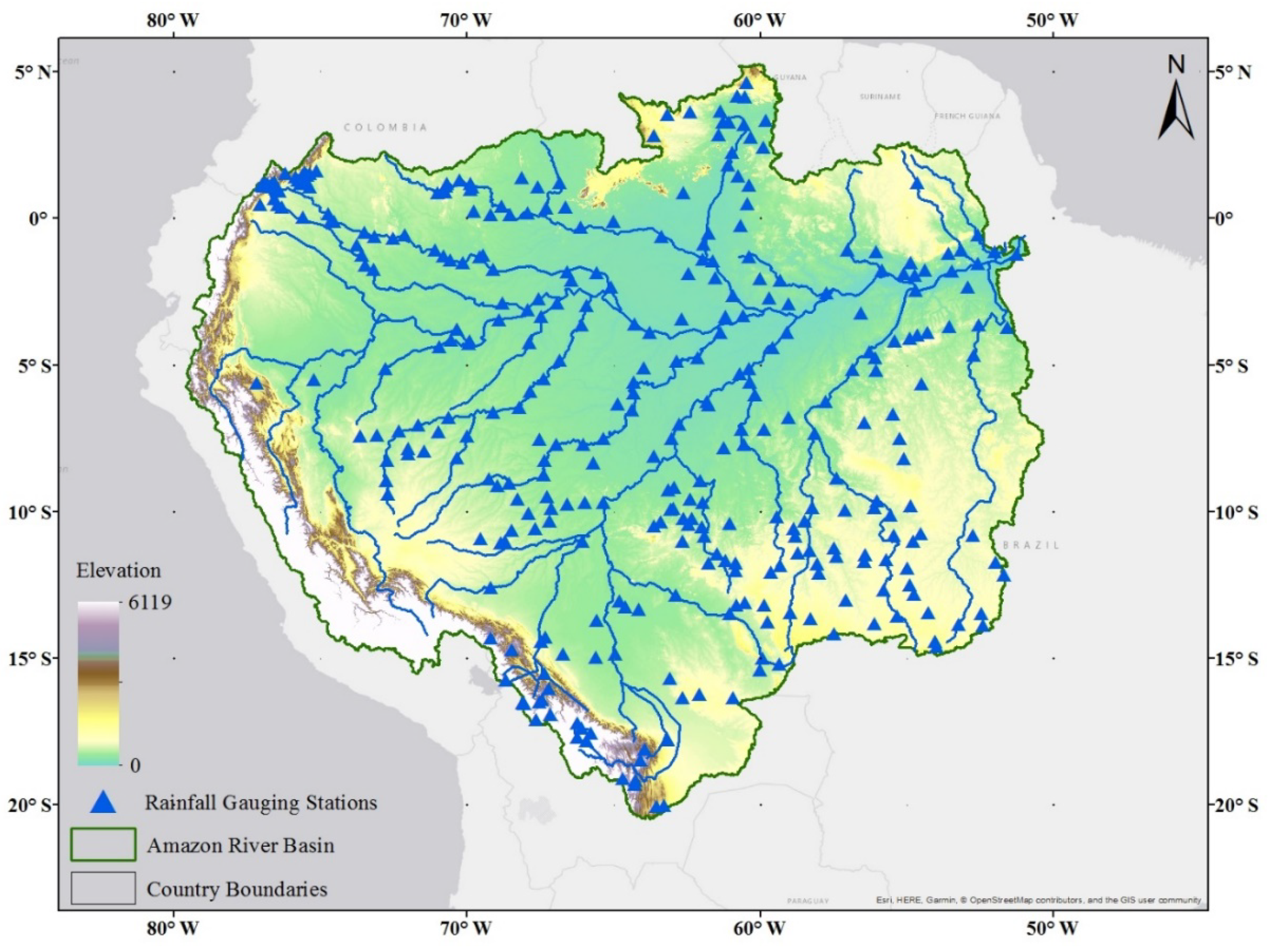
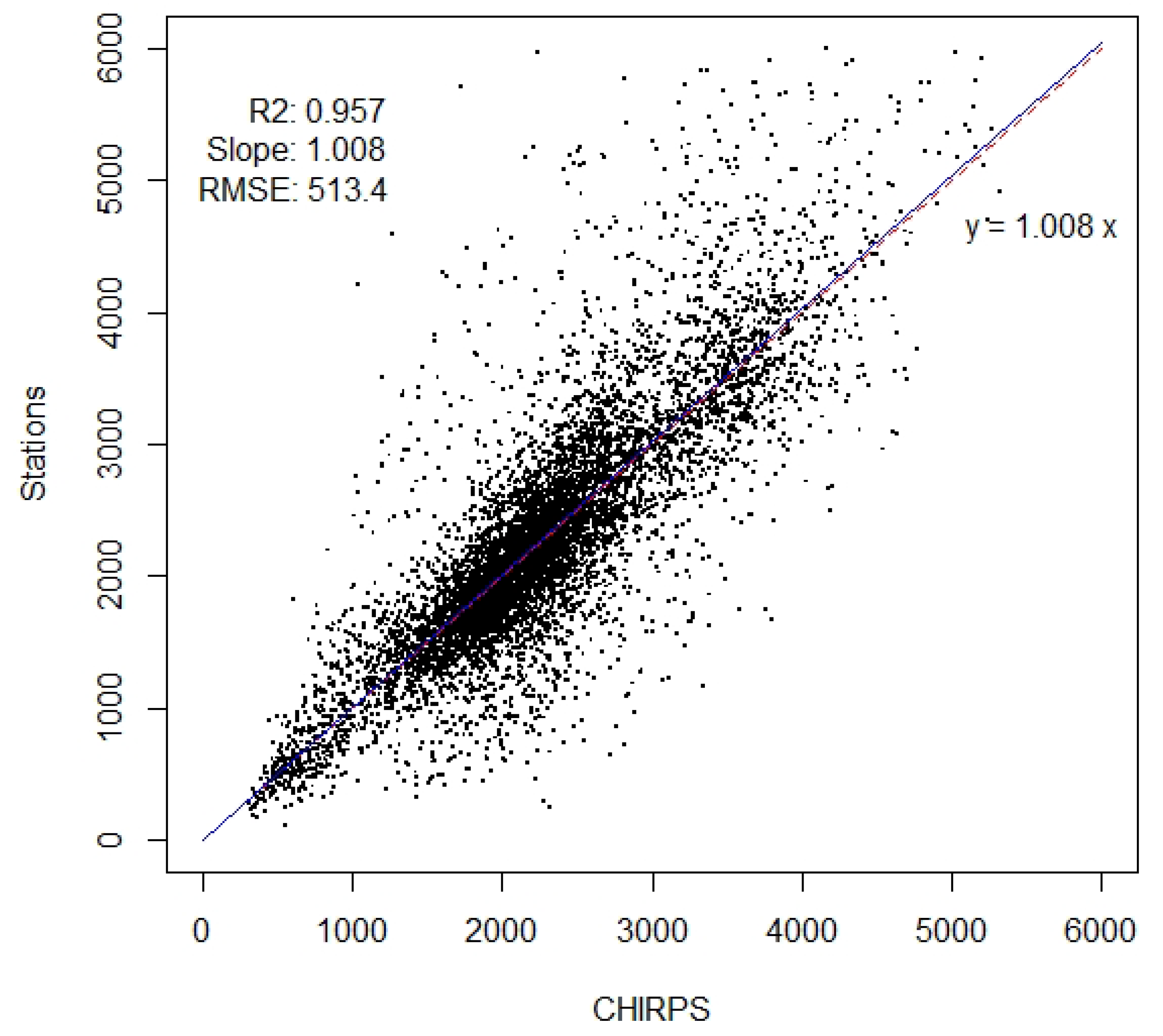
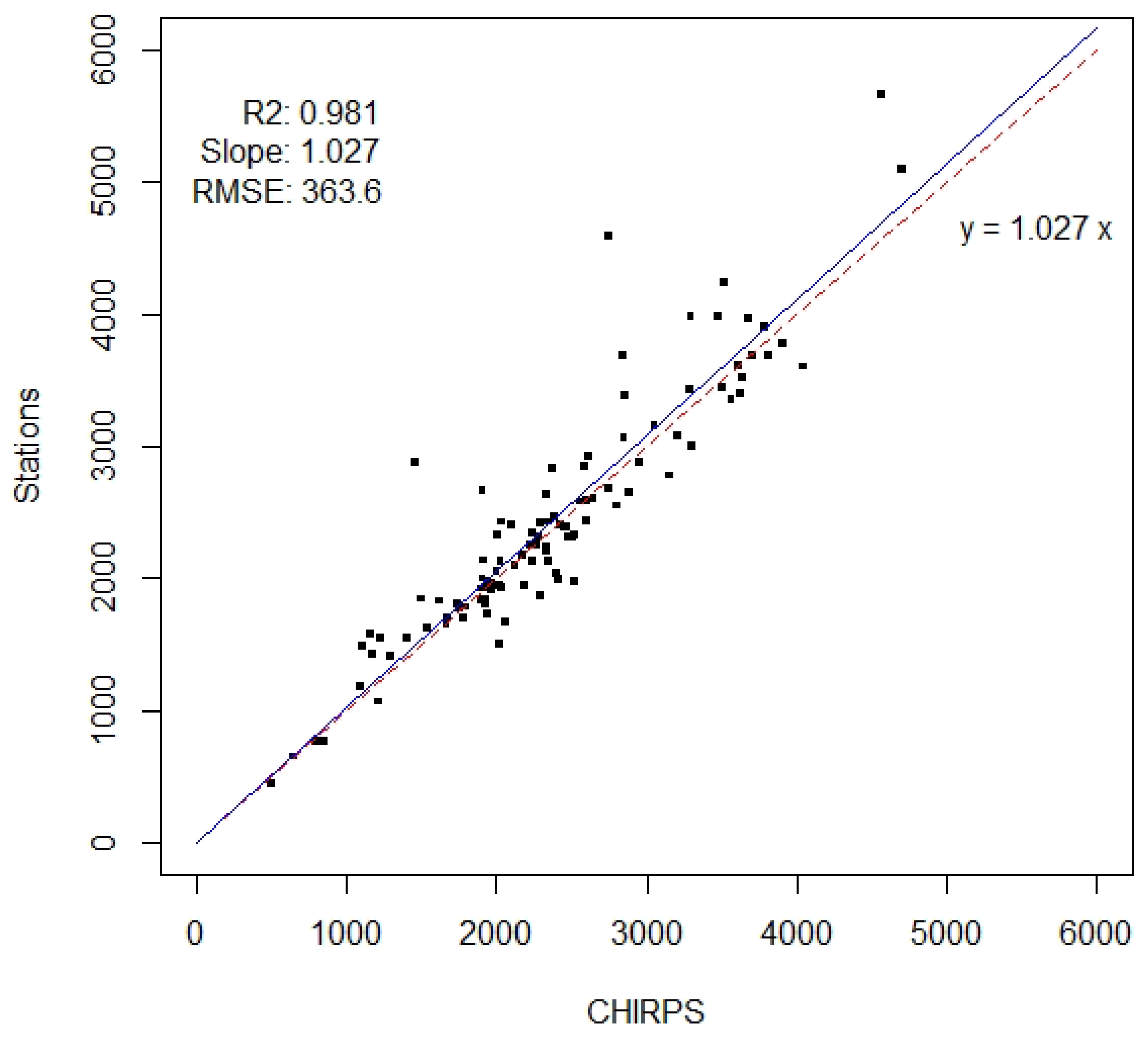
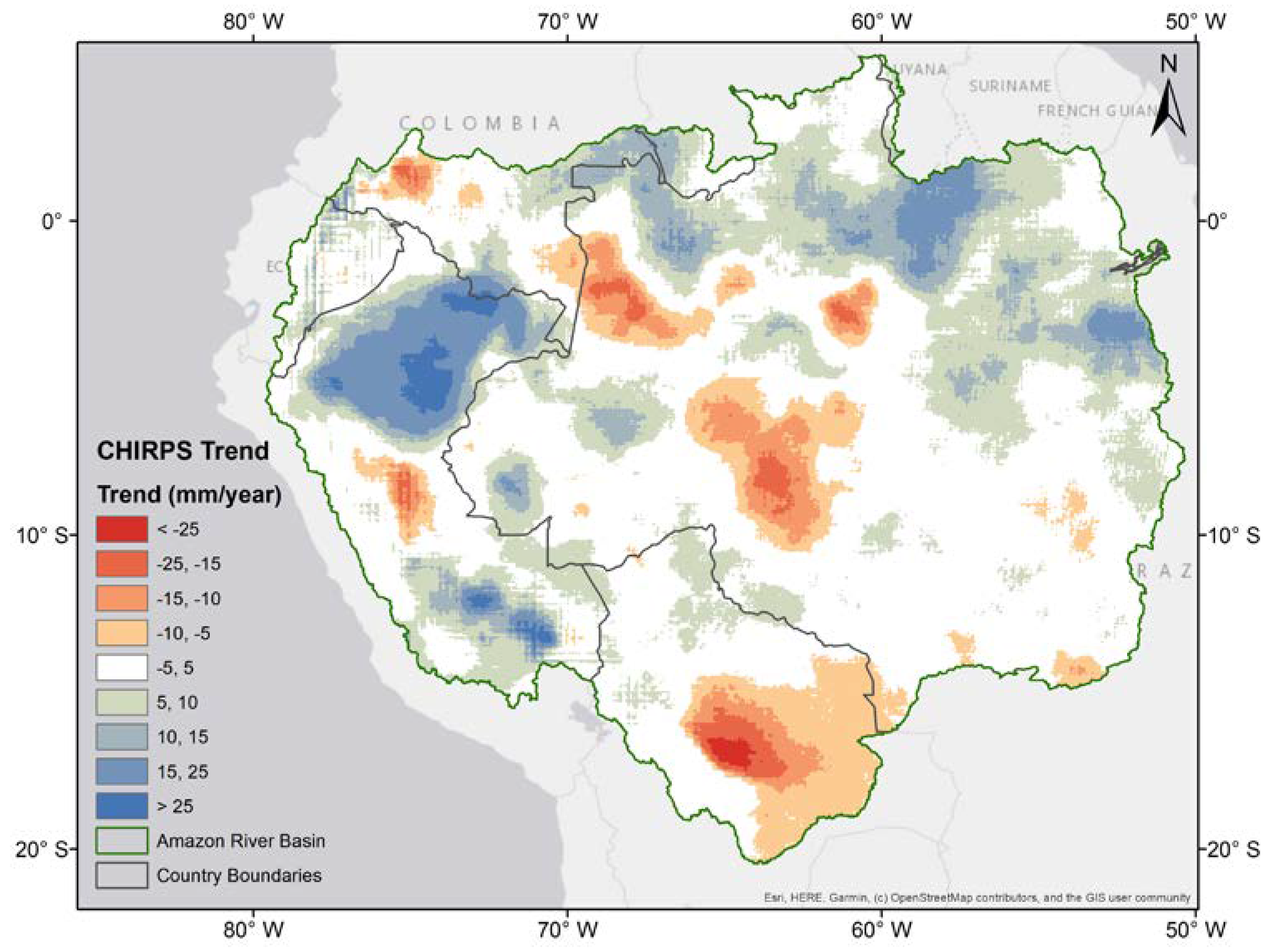
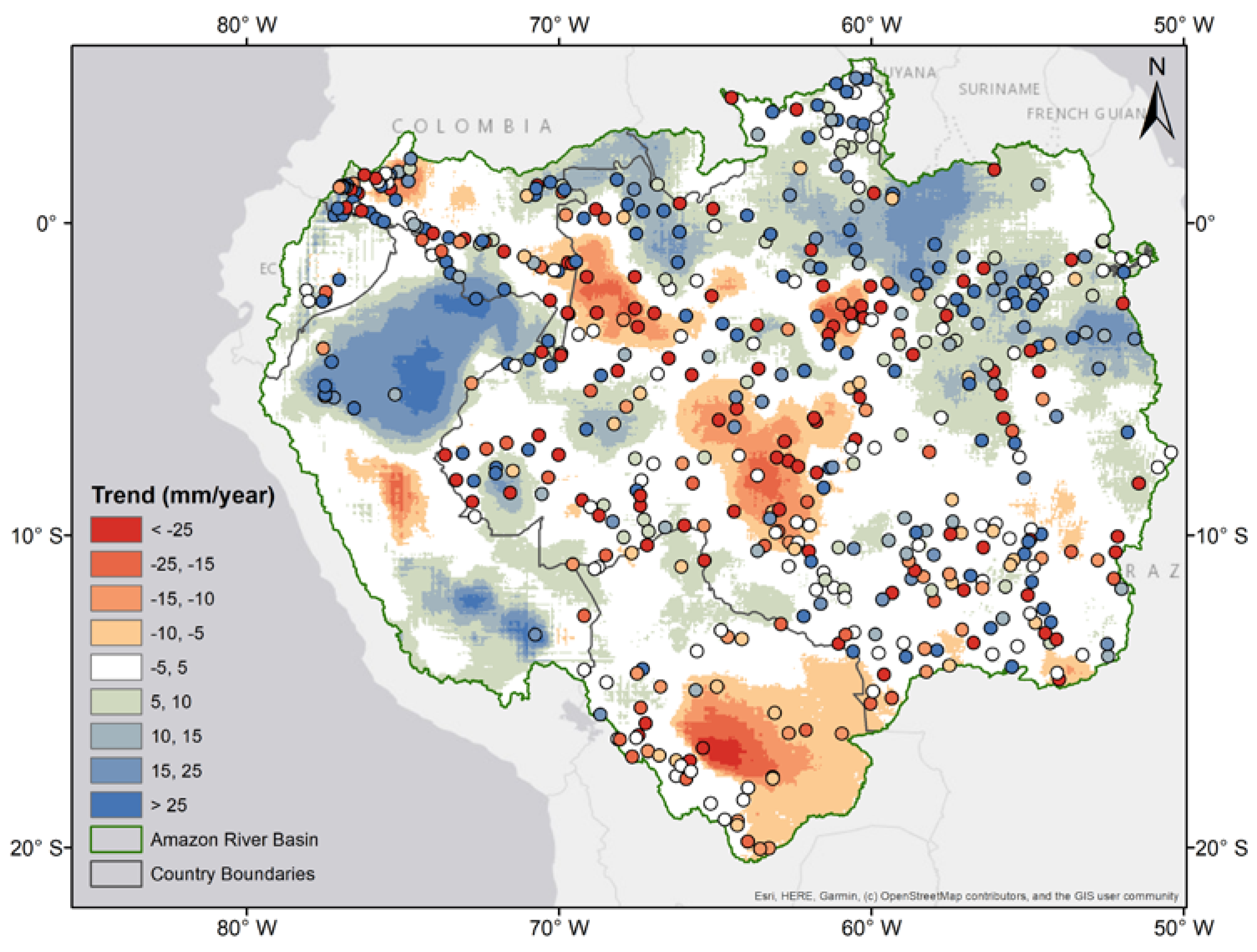
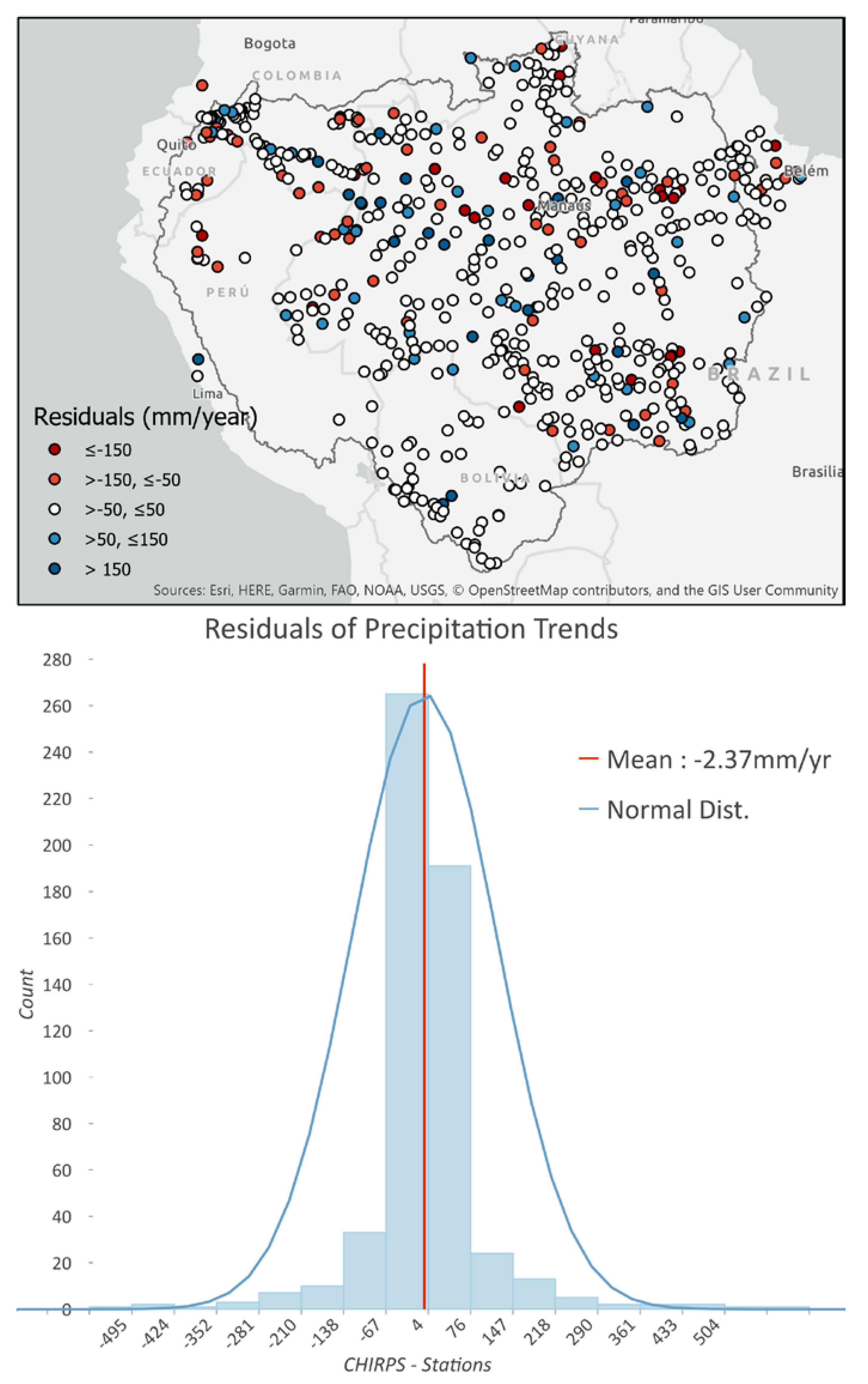

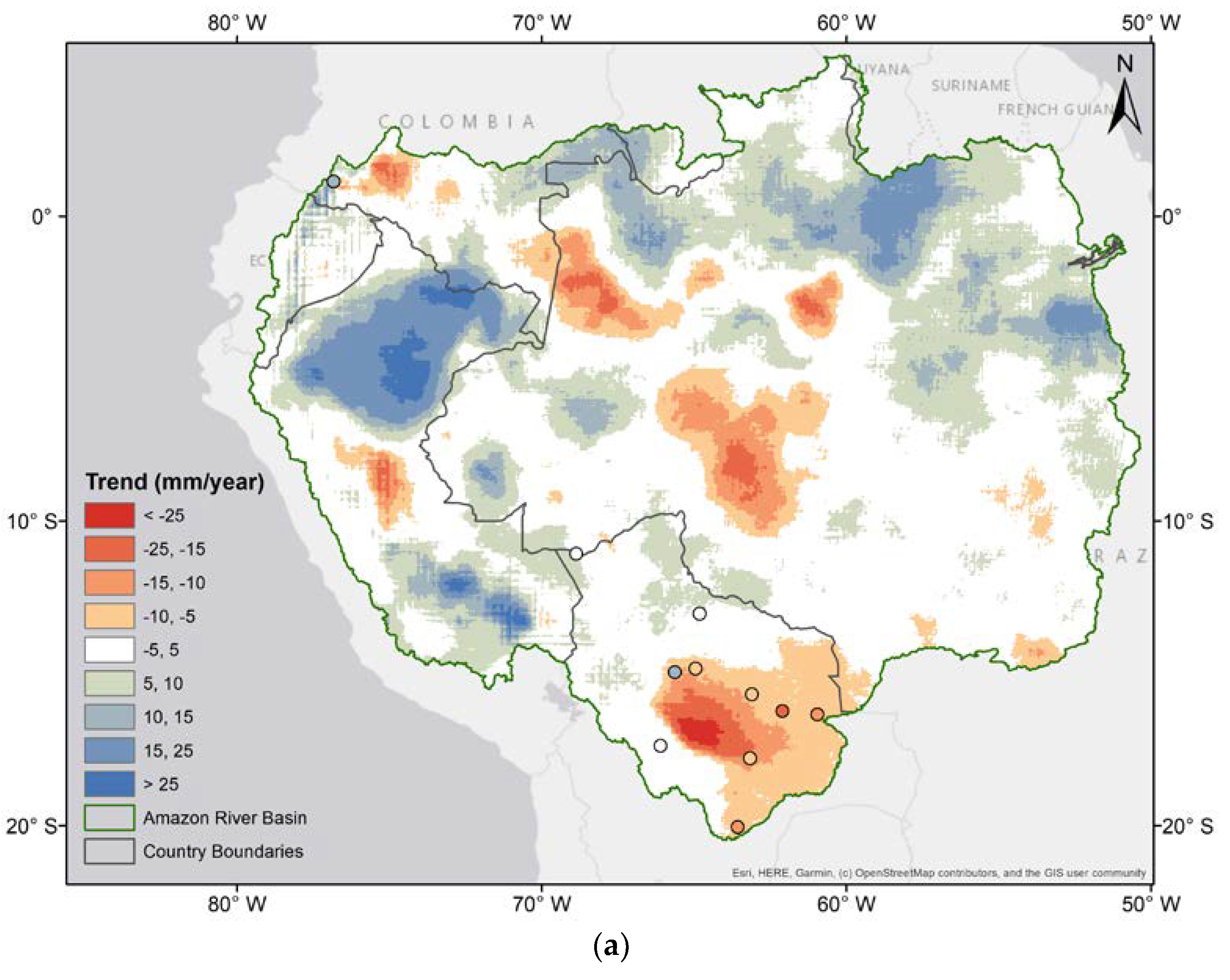
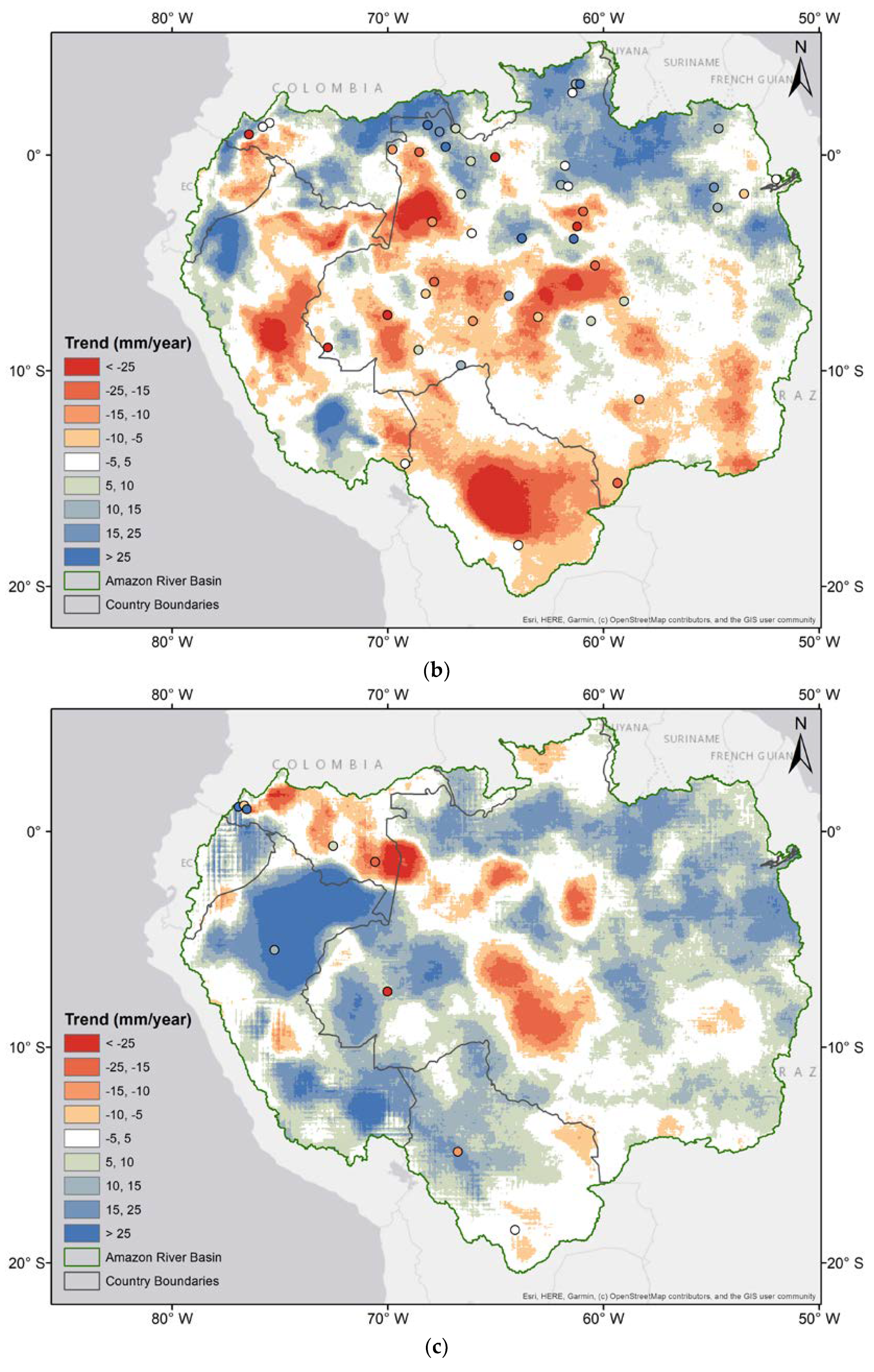
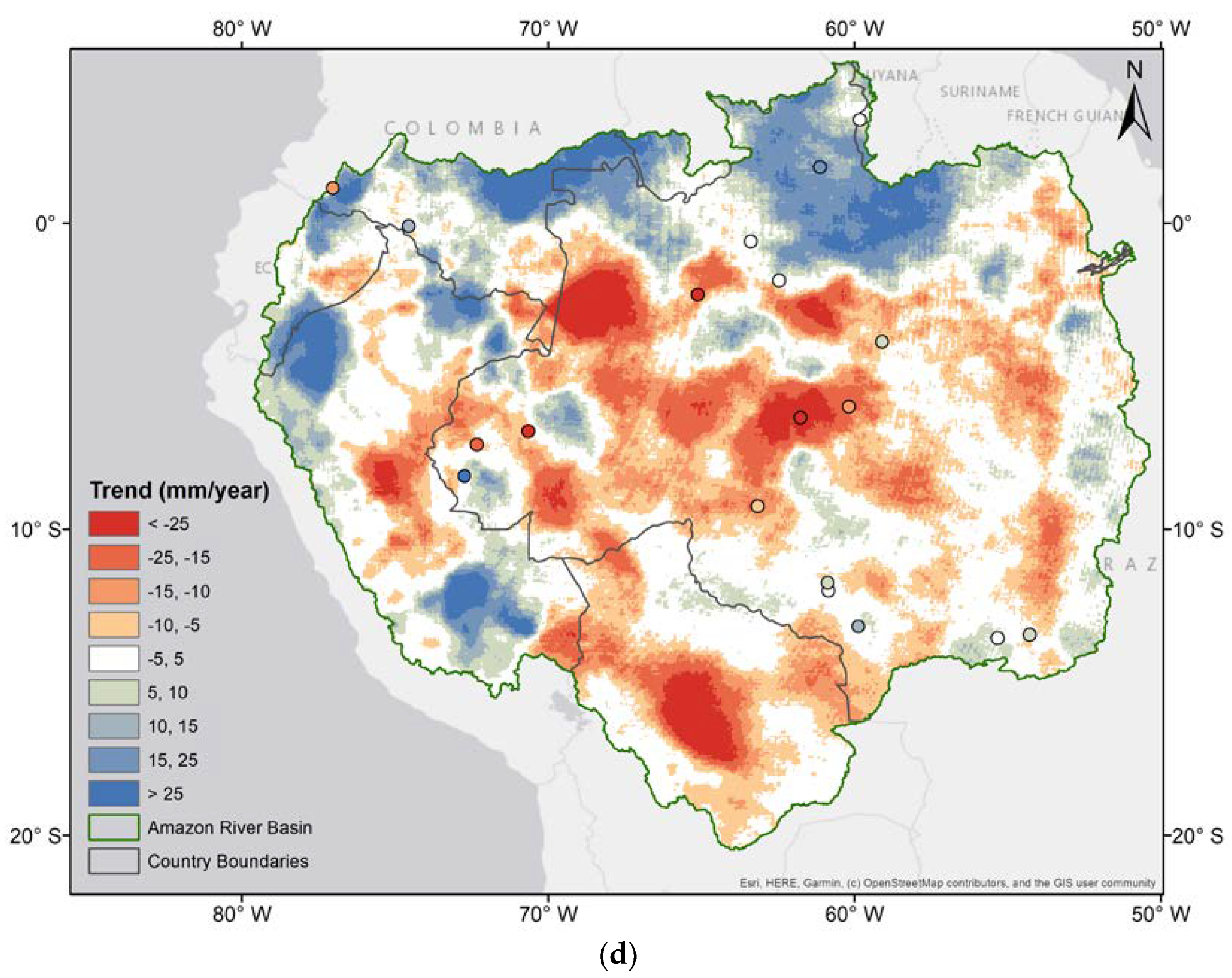
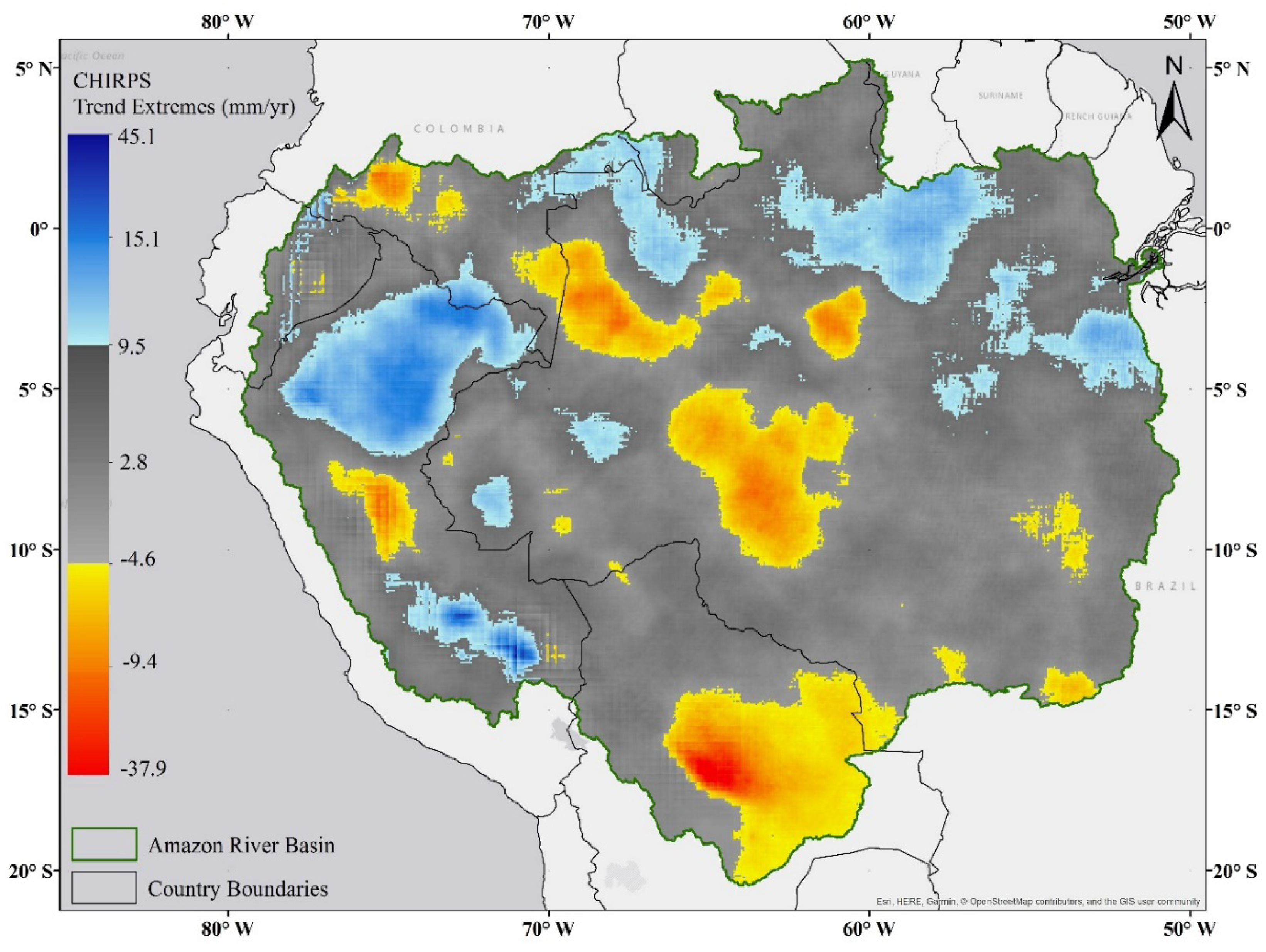
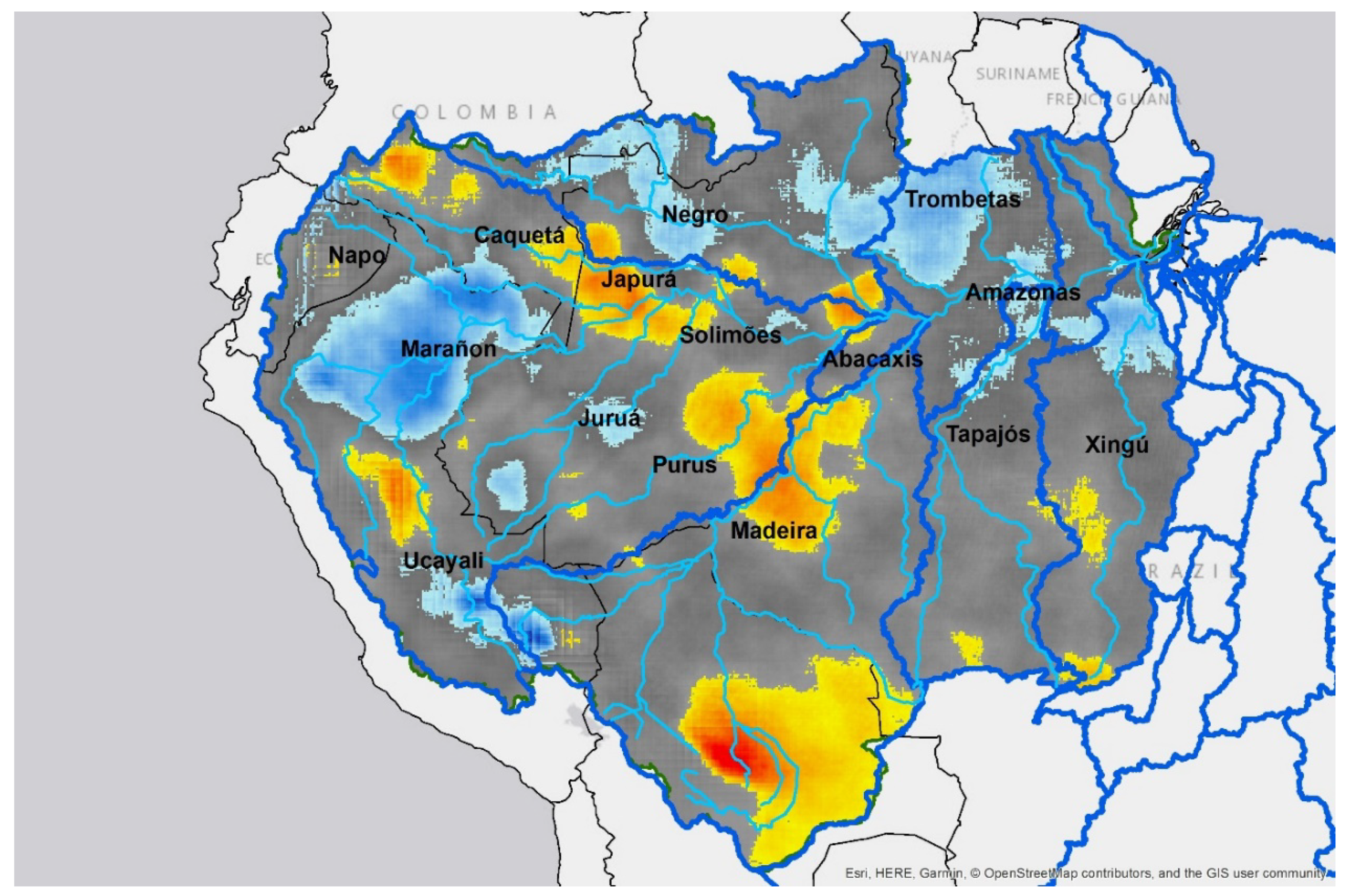
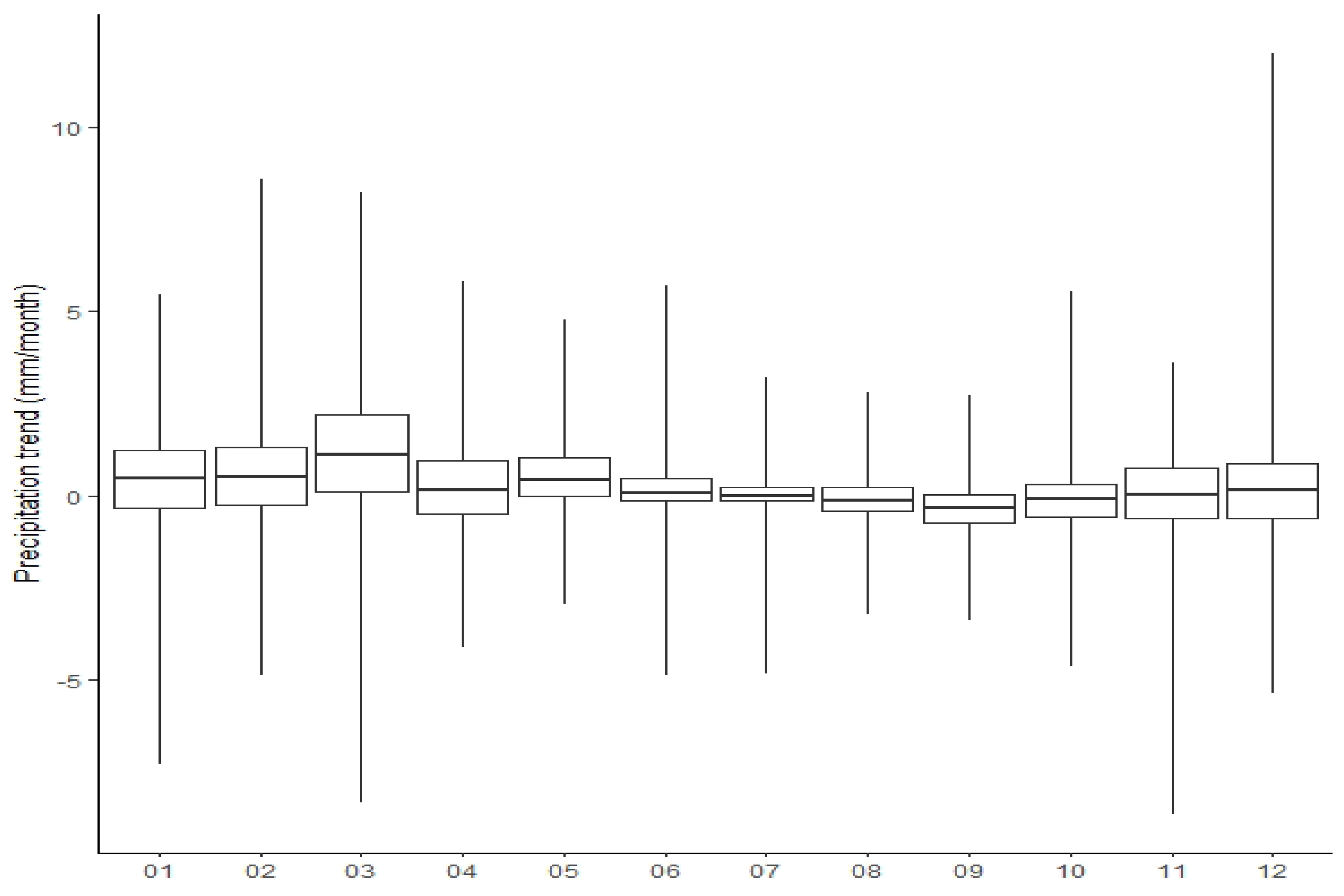
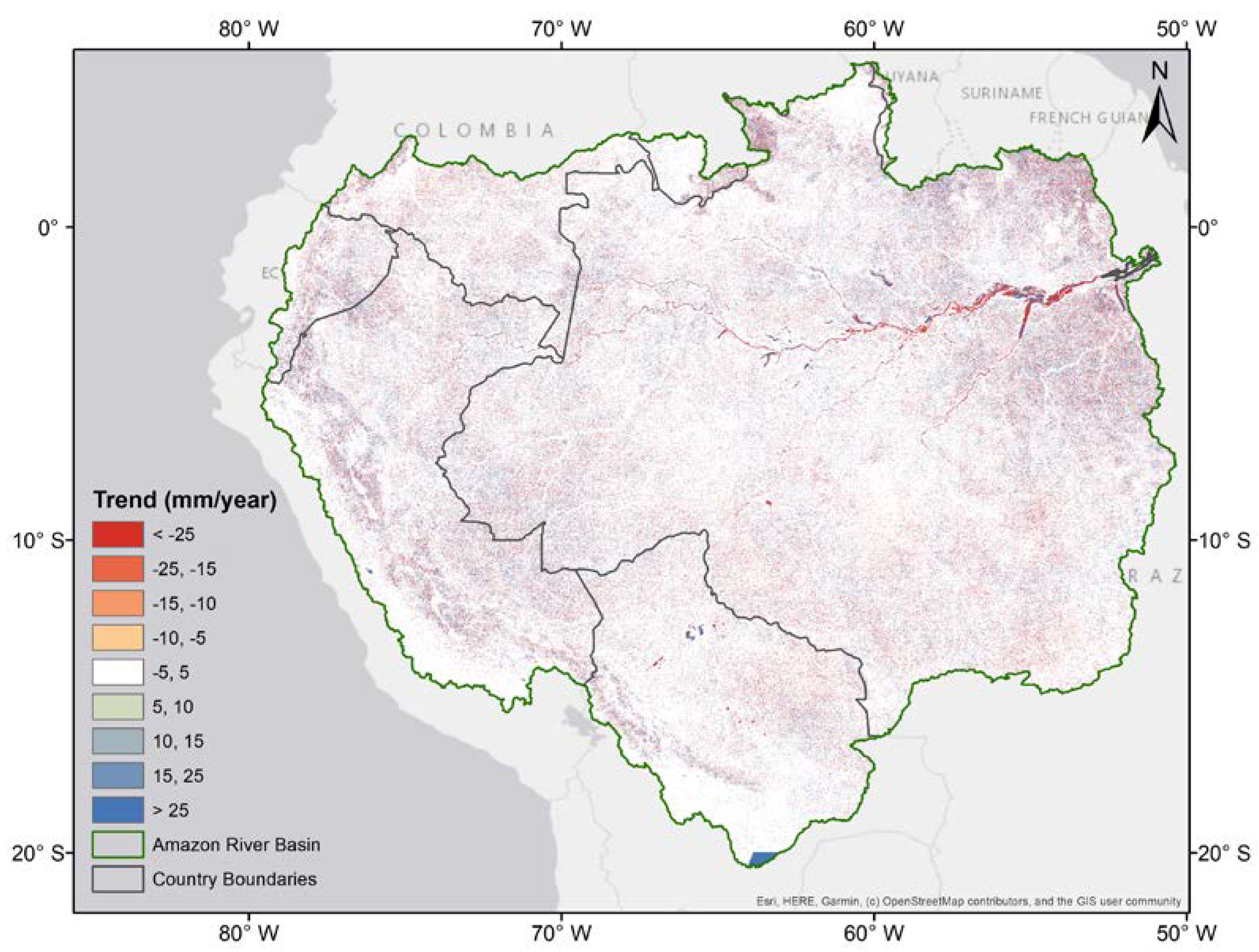
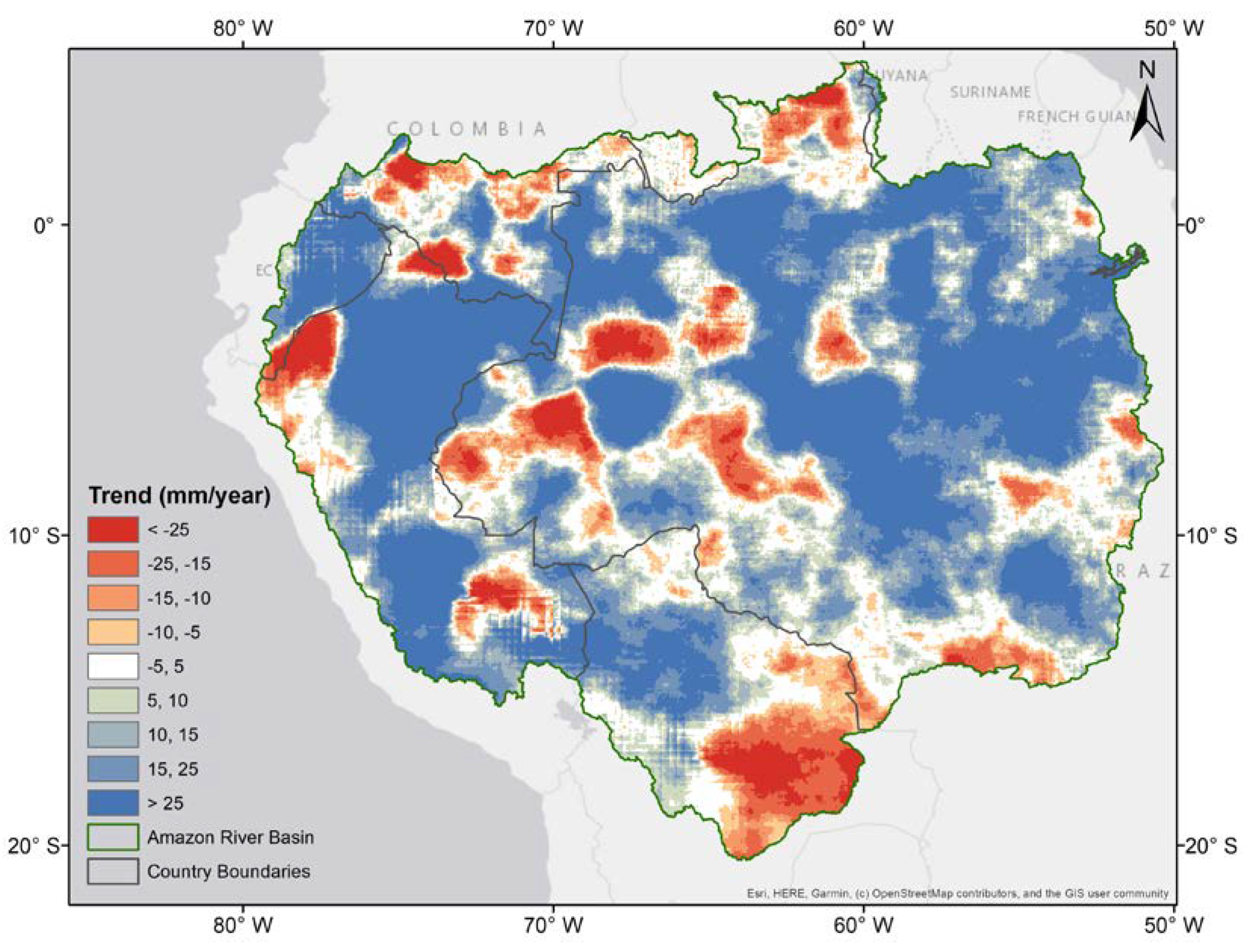
| Product | Main Principle Products | Resolution | Spatial Coverage | Minimum Time Steps Interval | Producer |
|---|---|---|---|---|---|
| CHIRPS | TMPA, TRMM 3B42-RT/3B42/2B31, CMORPH, ground stations | 0.05° | 50° N–S | daily | Climate Hazards Group (CHG) |
| Ground stations | Direct Observations | Locally based | In situ measurements | daily | Local Institutions |
| Sub-Basin | Country | Area (km2) | Max Trend (mm/year) | Mean Trend (mm/year) | p-Value | Volume (km3/year) | Volume (km3) (1981–2017) |
|---|---|---|---|---|---|---|---|
| Xingu | Brazil | 24,290.6 | −8.2 | −5.3 | 0.46 | −119.1 | −4409.5 |
| Solimões | Brazil | 35,366.3 | −17.5 | −7.4 | - | −264.9 | −9801.4 |
| Madeira/Solimões | Brazil | 231,532.9 | −19.3 | −5.4 | 0.04 | −1190.4 | −44045.6 |
| Tapajós | Brazil | 8096.8 | −7.1 | −5.0 | - | −40.5 | −1501.2 |
| Negro | Brazil/Colombia | 139,569.6 | −19.7 | −7.5 | 0.94 | −745.0 | −27,565.6 |
| Marañon/Ucayali | Peru | 48,364.6 | −19.5 | −5.5 | - | −266.3 | −1365.4 |
| Madeira/Purus | Brazil | 6824.1 | −10.1 | −5.4 | - | −36.9 | −82,720.9 |
| Madeira | Bolivia | 322,710.8 | −37.9 | −5.1 | 0.20 | −1662.4 | −61,510.3 |
| Caquetá/Japurá | Colombia | 41,269.7 | −19.8 | −5.2 | 0.42 | −217.3 | −8041.9 |
| Xingu/Tapajós | Brazil | 16,085.4 | −12.0 | −5.6 | - | −91.2 | −3375.3 |
| Total | - | 874,110.8 | −37.9 | −5.7 | −4634.0 | −244,337.1 |
| Sub-Basin | Country | Area (km2) | Max Trend (mm/year) | Mean Trend (mm/year) | p-Value | Volume (km3/year) | Volume (km3) (1981–2017) |
|---|---|---|---|---|---|---|---|
| Abacaxis | Brazil | 5361.8 | 13.0 | 9.8 | 0.38 | 52.7 | 1951.4 |
| Juruá Downstream | Brazil | 21,799.2 | 15.2 | 9.9 | - | 217.0 | 8031.1 |
| Juruá/Purus | Brazil | 17,304.0 | 16.7 | 12.4 | 0.64 | 215.1 | 7960.8 |
| Ucayali | Peru | 71,490.8 | 45.1 | 10.7 | - | 771.3 | 28,539.5 |
| Marañon | Peru | 308,927.1 | 29.4 | 10.6 | 0.01 | 3290.3 | 121,744.6 |
| Napo | Ecuador | 12,917.0 | 23.7 | 10.9 | 0.14 | 140.8 | 5212.0 |
| Negro | Brazil/Colombia | 122,698.9 | 17.6 | 10.0 | 0.04 | 1236.9 | 45,768.5 |
| Trombetas | Brazil | 203,640.6 | 22.8 | 10.0 | 0.24 | 2039.5 | 75,464.1 |
| Xingu downstream | Brazil | 125,298.5 | 21.9 | 9.9 | 0.27 | 1249.0 | 46,213.1 |
| Total | - | 889,437.9 | 45.1 | 10.4 | - | 9212.6 | 340,885.1 |
© 2020 by the authors. Licensee MDPI, Basel, Switzerland. This article is an open access article distributed under the terms and conditions of the Creative Commons Attribution (CC BY) license (http://creativecommons.org/licenses/by/4.0/).
Share and Cite
Paca, V.H.d.M.; Espinoza-Dávalos, G.E.; Moreira, D.M.; Comair, G. Variability of Trends in Precipitation across the Amazon River Basin Determined from the CHIRPS Precipitation Product and from Station Records. Water 2020, 12, 1244. https://doi.org/10.3390/w12051244
Paca VHdM, Espinoza-Dávalos GE, Moreira DM, Comair G. Variability of Trends in Precipitation across the Amazon River Basin Determined from the CHIRPS Precipitation Product and from Station Records. Water. 2020; 12(5):1244. https://doi.org/10.3390/w12051244
Chicago/Turabian StylePaca, Victor Hugo da Motta, Gonzalo E. Espinoza-Dávalos, Daniel Medeiros Moreira, and Georges Comair. 2020. "Variability of Trends in Precipitation across the Amazon River Basin Determined from the CHIRPS Precipitation Product and from Station Records" Water 12, no. 5: 1244. https://doi.org/10.3390/w12051244
APA StylePaca, V. H. d. M., Espinoza-Dávalos, G. E., Moreira, D. M., & Comair, G. (2020). Variability of Trends in Precipitation across the Amazon River Basin Determined from the CHIRPS Precipitation Product and from Station Records. Water, 12(5), 1244. https://doi.org/10.3390/w12051244






